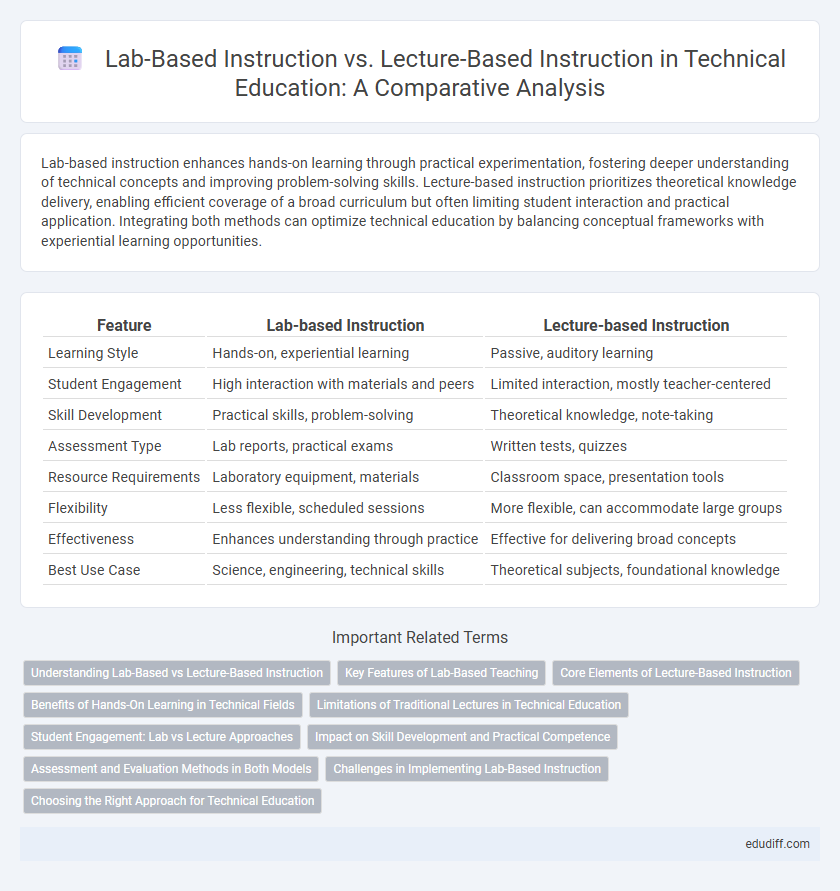Lab-based instruction enhances hands-on learning through practical experimentation, fostering deeper understanding of technical concepts and improving problem-solving skills. Lecture-based instruction prioritizes theoretical knowledge delivery, enabling efficient coverage of a broad curriculum but often limiting student interaction and practical application. Integrating both methods can optimize technical education by balancing conceptual frameworks with experiential learning opportunities.
Table of Comparison
| Feature | Lab-based Instruction | Lecture-based Instruction |
|---|---|---|
| Learning Style | Hands-on, experiential learning | Passive, auditory learning |
| Student Engagement | High interaction with materials and peers | Limited interaction, mostly teacher-centered |
| Skill Development | Practical skills, problem-solving | Theoretical knowledge, note-taking |
| Assessment Type | Lab reports, practical exams | Written tests, quizzes |
| Resource Requirements | Laboratory equipment, materials | Classroom space, presentation tools |
| Flexibility | Less flexible, scheduled sessions | More flexible, can accommodate large groups |
| Effectiveness | Enhances understanding through practice | Effective for delivering broad concepts |
| Best Use Case | Science, engineering, technical skills | Theoretical subjects, foundational knowledge |
Understanding Lab-Based vs Lecture-Based Instruction
Lab-based instruction fosters experiential learning by engaging students in hands-on activities that reinforce theoretical concepts, enhancing comprehension and retention. Lecture-based instruction prioritizes structured delivery of information, enabling efficient dissemination of foundational knowledge to large audiences. Combining both methods can optimize understanding by balancing practical application with conceptual frameworks.
Key Features of Lab-Based Teaching
Lab-based instruction emphasizes hands-on experimentation, fostering practical skills and active learning through direct interaction with materials and equipment. It enhances critical thinking and problem-solving by allowing students to apply theoretical concepts in real-world scenarios. This method also promotes collaborative learning and immediate feedback, which are less prominent in traditional lecture-based teaching.
Core Elements of Lecture-Based Instruction
Lecture-based instruction centers on a structured delivery of content through verbal presentations by the instructor, emphasizing clear articulation of key concepts, theories, and principles. Core elements include a well-organized syllabus, extensive use of visual aids such as slides or charts, and continuous instructor-led explanations to facilitate understanding. This method often incorporates scheduled question-and-answer sessions to reinforce knowledge and clarify complex technical subjects.
Benefits of Hands-On Learning in Technical Fields
Hands-on learning in technical fields enhances practical skill development by allowing students to directly apply theoretical concepts in lab settings, fostering deeper understanding and retention. Lab-based instruction encourages critical thinking and problem-solving through real-world experimentation, which lecture-based approaches often lack. This immersive experience builds technical proficiency and prepares students for industry challenges by simulating authentic work environments.
Limitations of Traditional Lectures in Technical Education
Traditional lecture-based instruction often limits student engagement and practical skill development in technical education, as it primarily emphasizes passive information transfer without hands-on application. This approach can hinder the understanding of complex engineering concepts and reduce the ability to solve real-world technical problems. Consequently, learners may struggle to retain knowledge and fail to develop the critical thinking and troubleshooting skills essential for technical proficiency.
Student Engagement: Lab vs Lecture Approaches
Lab-based instruction significantly enhances student engagement by offering hands-on experiences that foster active learning and critical thinking. In contrast, lecture-based instruction often results in passive information absorption, limiting opportunities for interactive participation and immediate skill application. Empirical studies reveal that students involved in lab activities demonstrate higher retention rates and improved problem-solving abilities compared to those in traditional lecture settings.
Impact on Skill Development and Practical Competence
Lab-based instruction significantly enhances skill development and practical competence by providing hands-on experience with real equipment and scenarios, fostering critical thinking and problem-solving abilities. Lecture-based instruction primarily delivers theoretical knowledge, which may limit students' ability to apply concepts in real-world contexts or develop technical proficiency. Integrating lab sessions within curricula promotes deeper understanding and prepares learners for industry demands by simulating authentic technical challenges.
Assessment and Evaluation Methods in Both Models
Lab-based instruction utilizes formative assessments such as practical experiments, real-time problem-solving tasks, and skill demonstrations to evaluate students' applied knowledge and technical proficiency. Lecture-based instruction relies predominantly on summative assessments including exams, quizzes, and written assignments that measure theoretical understanding and content retention. Combining both methods enhances comprehensive evaluation by integrating practical mastery with conceptual learning.
Challenges in Implementing Lab-Based Instruction
Implementing lab-based instruction faces challenges such as high costs for specialized equipment and maintenance, limited availability of trained personnel, and constraints on classroom space and scheduling. Ensuring student safety during hands-on activities requires rigorous supervision and adherence to stringent protocols. Furthermore, integrating lab activities into existing curricula demands meticulous planning to align with learning objectives and assessment methods.
Choosing the Right Approach for Technical Education
Lab-based instruction enhances hands-on skills and practical problem-solving by immersing students in real-world technical scenarios, fostering deeper understanding of complex concepts. Lecture-based instruction efficiently delivers foundational theoretical knowledge to large groups, supporting structured learning and broad coverage of technical subjects. Selecting the optimal approach depends on course objectives, balancing theory acquisition with experiential learning to maximize technical competency and student engagement.
Lab-based Instruction vs Lecture-based Instruction Infographic

 edudiff.com
edudiff.com